Searsia lucida
Searsia lucida (L.) F.A.Barkley
Family: Anacardiaceae
Common names: glossy crowberry, glossy currant, glossy wild currant (Eng.); blinktaaibos, slaptaaibos (Afr.); intlokolotshane-ebomvu, umchane, amapozi (isiXhosa); inhlokoshiyane (isiZulu)
SA Tree No: 388
Introduction
A versatile shrub or small tree, with attractive shiny leaves and creamy white flowers, which are followed by green fruits that ripen to red-brown and are relished by birds.
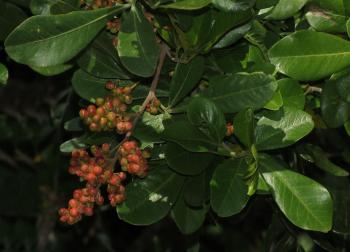
Description
Description
Searsia lucida is a densely branched, evergreen shrub, 2–3 m tall or occasionally a small tree, up to 5 m tall; erect branches can have a spread of up to 4 m. The rough grey to brown bark is slightly fissured. Young reddish brown branchlets are covered in a shiny resin. The wood is red-brown, hard, tough and durable. Leaves are glossy, trifoliate (have three leaflets) with a larger terminal leaflet, slightly leathery, rather sticky, dark olive-green above and below, with a prominent midrib. Leaves turn an orange-yellow colour before being shed. If the surface of the leaf is lightly scratched the cuticle becomes milky, so leaves often appear to have a white hue.
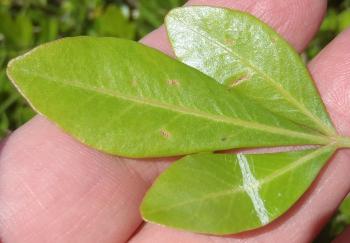
Small, creamy white flowers are borne in sprays up to 50 mm long which originate from the leaf axils from August to February. Small, round fruits, up to 5 mm in diameter, occur from spring until mid-winter (from October to June). Initially green, the berries turn shiny brown as they mature.
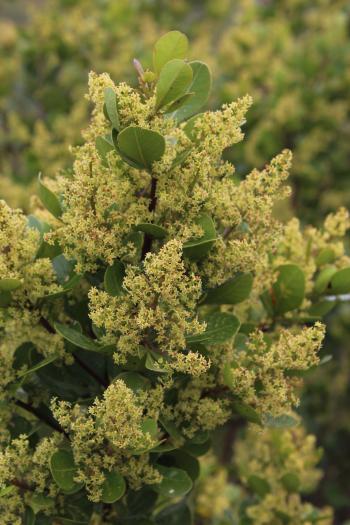
Conservation Status
Status
According to the Red List website http://redlist.sanbi.org checked on 27 November 2015 the conservation status of Searsia lucida is Least Concern (LC). The three forms that are now recognised have not been evaluated as yet, so Searsia lucida forma lucida, forma elliptica and forma scoparia have a conservation status of Not Evaluated.
Distribution and habitat
Distribution description
Searsia lucida is found in scrub forest or on forest margins from sea level to 2 000 m in altitude, from the West Coast all the way round, through to Mozambique. Its distribution area also encompasses the whole of southern, southwestern and Eastern Cape, KwaZulu-Natal and stretches in an arm past Swaziland, right up the Lowveld areas of Mpumalanga and into Limpopo Province, almost to the Zimbabwe border.
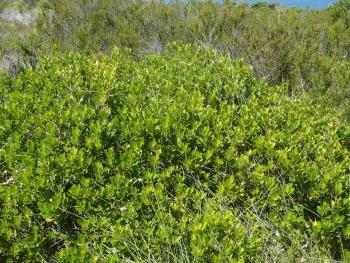
Derivation of name and historical aspects
History
Most of the species grown in southern Africa, belonging to the genus Rhus, have been placed in Searsia. Searsia was named after Paul B. Sears (1891–1990) who was head of the Yale School of Botany. The specific epithet, lucida, means ‘shining’, referring to the glossiness of the leaves. Other noteworthy species are Searsia chirindensis, S. glauca, S. lancea, S. leptodictya, S. nebulosa and S. pendulina.
Anacardiaceae is widespread throughout the tropical, subtropical and warm temperate regions of the world with about 600 species. Boasting economically important exotic species such as the pistachio nut (Pistacia vera), cashew (Anacardium occidentale), and mango fruit (Mangifera indica).
Other exotic species within the family that are important are the pepper tree (Schinus molle ) and the Brazilian pepper tree (Schinus terebinthifolius), from South America, because of their invasive nature in South Africa. A few indigenous species that belong to this family are wild plum (Harpephyllum caffrum) and the marula (Sclerocarya caffra).
In southern Africa, there are about 91 taxa of Searsia, including the commonly cultivated karee (Searsia lancea) and witkaree (Searsia pendulina), and with about 80 trees and shrubs, it is the fourth largest tree family.
Ecology
Ecology
Searsia lucida plays an important role as a pioneer species in the ecological cycle of plant succession, as it is able to establish itself under harsh environmental conditions, such as drought, salt spray and high wind, often providing shelter for less tough and slower-growing species.
Leaves of species of Searsia have a resinous smell when crushed. Stems and branches of this genus have prominent lenticels, and galls are often found on the leaflets. Bees and other insects pollinate the flowers and birds eat the ripe berries. A wide variety of butterflies breed on various Searsia species.
Uses
Use
The currant-like fruits of all the Searsia species are edible. They are quite sour to the taste and traditional beer can be made from fermenting the fruit. In former times they were ground into a meal and used to make cakes that were roasted on the embers.
The flexible, resilient and tough branches were once used to make bows and kieries, and to make serviceable and durable hand or yard brooms. The dense hard wood can be used for fence posts. The bark was once used for tanning.
Searsia lucida is useful for conserving soil, preventing erosion, and is often used for stabilizing coastal dunes, as well as being a good garden subject, in harsh coastal environments.
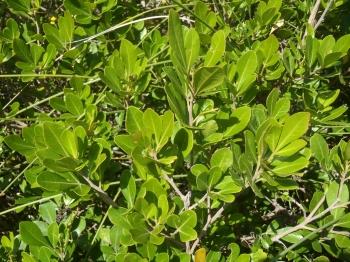
Growing Searsia lucida
Grow
Fast-growing, low maintenance shrub that does best in the full sun. Very well adapted to harsh coastal conditions and so can tolerate poor soil and salty conditions and can thrive inwindy and drought conditions. Suitable for water-wise gardening and can also survive frost. Grow as a specimen shrub or in a group. Dense green foliage provides a good backdrop for flowering species or grey-foliaged plants.
Evergreen and fast growing, it can be used for informal hedging and screening. Makes an excellent coastal hedge or screen and will provide shade and shelter for slower, softer plant species.
Attracts berry- and fruit-eating birds to a garden. Because Searsia lucida is so hardy it does not require any special attention once it is established.
Searsia lucida can be propagated easily from seed or semi-hardwood cuttings
The seeds usually have a shiny brown colouring when ripe. As soon as the seeds are dry, they can be collected. Sow the ripe seed in autumn in seedling trays using a well-drained seedling medium. Only lightly cover the seeds with soil, and keep them moist, but never too damp. Seeds should start germinating from about four to six weeks after sowing. Transplant the seedlings into bigger containers when they reach the two-leaf stage. Sow fresh seed for best germination results. To improve germination first soak the berries till the flesh of the fruit rubs off easily, before sowing seed.
Cuttings can be taken in spring and early summer. Make semi-hardwood tip cuttings and use a rooting hormone to improve rooting success. Cuttings perform best if they are placed on a heating bench with an automated irrigation system, and enough air movement in the greenhouse. Should develop roots within three to five weeks if placed on bottom heat, after which they can be hardened off without heat, and watered less often for two weeks before being potted up.
References
- Coates Palgrave, M. 2002. Keith Coates Palgrave Trees of southern Africa , edn 3. Struik, Cape Town.
- Goldblatt, P. & Manning, J. 2000. Cape Plants. A conspectus of the Cape flora of South Africa. Strelitzia 9. National Botanical Institute, Pretoria & Missouri Botanical Garden, Missouri.
- Honig, M. 2014. Indigenous plant palettes. Quiver Tree Publications, Cape Town.
- Johnson, D. & Johnson, S.1993. Gardening with indigenous trees and shrubs. Southern Book Publishers, Cape Town.
- Leistner, O.A. (ed.). 2000. Seed plants of southern Africa: families and genera. Strelitzia 10. National Botanical Institute, Pretoria.
- Leistner, O.A. 2005. Seed plants of southern tropical Africa: families and genera. Southern African Botanical Diversity Network Report No. 26. SABONET, Pretoria
- Moffett, R.O. 2007. Name changes in the Old World Rhus and recognition of Searsia (Anacardiaceae). Bothalia 37(2):165–175.
- Pooley, E. 2003. The complete field guide to trees of Natal, Zululand and Transkei, Edn 1. Natal Flora Publication trust. Pp.188, 189.
- Powrie, F. 1998. Grow South African Plants. A gardener's companion to indigenous plants. National Botanical Institute, Cape Town.
- Smith, C.A. 1966. Common names of South African plants. Memoirs of the Botanical Survey of South Africa No. 35. Government Printer, Pretoria.
- Von Breitenbach, F . 1974. Southern Cape forests and trees. The Government Printer, Pretoria.
- Wilkinson, J. 2014. Gardens in the sand: Strandveld gardening. Marina da Gama Garden Club, Cape Town.
- iSpot southern Africa https://www.ispotnature.org/communities/southern-africa
Credits
Cherise Viljoen
Kirstenbosch National Botanical Garden
December 2015
Plant Attributes:
Plant Type: Shrub, Tree
SA Distribution: Eastern Cape, KwaZulu-Natal, Limpopo, Mpumalanga, Western Cape
Soil type: Sandy, Loam
Flowering season: Spring, Early Summer, Late Summer
PH: Acid, Neutral
Flower colour: White, Cream
Aspect: Full Sun, Morning Sun (Semi Shade), Afternoon Sun (Semi Shade)
Gardening skill: Easy
Special Features:
Horticultural zones











Rate this article
Article well written and informative
Rate this plant
Is this an interesting plant?
Login to add your Comment
Back to topNot registered yet? Click here to register.